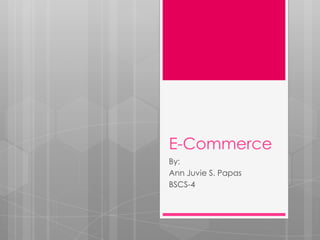E commerce papas
- 1. E-Commerce By: Ann Juvie S. Papas BSCS-4
- 2. Introduction to E-Business and E-commerce ï Business transactions take place via telecommunications networks, especially the Internet. ï Buying and selling of products, services, and information via computer networks including the Internet. ï Doing business electronically. ï An electronically mediated financial transactions between organizations and customers.
- 3. E-commerce Fundamentals ï user experience. ï Solid âon-site searchâ functionality is vital. ï Well-defined information architectureand intuitive navigation is essential. ï Clearly label categories and pages. ï Trust and credibility need to be reinforced, particularly in key purchase areas, and especially for new or unknown brands.
- 4. E-commerce Fundamentals ï Prioritize the key information users look for during the purchase decision-making process. ï Minimize distractions â keep the user focused on the purchase or conversion goal. ï Good copy. ï Images. ï Service the pre-purchase consumer
- 5. E-commerce Fundamentals ï No alarms and no surprises. ï Highly visible support options.
- 6. E-Business Infrastructure ï Architecture of hardware, software, content and data used to deliver e- business services to employees, custom.ers and partners. ï Vital to all companies adopting e-business as it affects directly the quality of service experience by users.
- 7. E- Environment ï Risk ï The overarching risk to any business doing online transactions is not having an overall E-commerce strategy, especially when it comes to the compliance requirements of which a merchant may or may not fully understand or even be aware. ï Availability ï lack of which is a big risk to an E-commerce
- 8. E- Environment ï Performance ï . Performance should be considered throughout the entire E-commerce environmentâfrom network throughput to disk I/O and even memory or CPU utilizationâas the single weakest link can cause the entire environment to respond poorly. ï Scalability ï Scalability for an E-commerce site or environment could mean different things to different merchants. ï Security ï Security is perhaps the broadest topic when it comes to an E-commerce site.
- 10. E- Marketing ï Provides businesses and advertisers with an easily customized, efficient form of marketing to complement existing advertising strategies and close in on the elusive and profitable interactive market.
- 11. E- Marketing Priorities ï We divide web site marketing into three primary divisions: ï Enticing visitors (non-customers) to come to the site ï Converting visitors (non-customers) into customers ï Site Effectiveness
- 12. E- Marketing Priorities ï The benefits of E-Marketing include: ï Speed ï Ease and Efficiency ï Low Cost ï Targeted ï Quality and efficiency ï Decrease in overall costs ï Increase Profitability
- 13. Customer Relationship Management ï company-wide business strategy designed to reduce costs and increase profitability by solidifying customer satisfaction, loyalty, and advocacy. ï brings together information from all data sources within an organization.
- 14. Change Management ï Approach to shifting/transitioning individuals, teams, and organizations from a current state to a desired future state. ï Organizational process aimed at helping change stakeholders.
- 15. Analysis and Design: M-commerce ï creating entirely new opportunities both for mobile devices and services. ï transactions using a wireless device and data connection ï The mobile industry today is rapidly growing because of its design , functionality and its services to the consumer.
- 16. Management of Mobile commerce Services ï Content development and distribution to hand- held devices, content caching, pricing of mobile commerce services. ï The role of emerging wireless LANs and 3G/4G wireless networks, personalized content management, implementation challenges in m- commerce, futuristic m-commerce services. ï The emerging issues in mobile commerce is the emerging wireless LANs and 3G/4G wireless networks, personalized content management, implementation challenges in m- commerce, futuristic m-commerce services
















